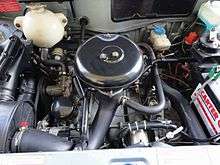PSA-Renault X-Type engine
| X engine | |
|---|---|
| Overview | |
| Manufacturer | Française de Mécanique |
| Production | – |
| Combustion chamber | |
| Configuration | inline-four |
| Chronology | |
| Successor | PSA TU engine |

The PSA X engine is a family of internal combustion engines used in Citroën, Peugeot, Talbot and Renault automobiles. The X family was mainly used in superminis and the entry level models of midsize vehicles. It is commonly called the "Douvrin" or the "Suitcase" engine. It is designed and manufactured by the company "Française de Mécanique" for PSA and Renault.
The X design was introduced in 1972 with the Peugeot 104. It was an all-aluminium alloy SOHC inline-four design with two valves per cylinder driven by a chain, using petrol as fuel. It was applied transversely in front wheel drive vehicles only, tilted by an almost horizontal attitude of 72°. The integral transmission is mounted on the rear side of the crankcase (thus appearing to be underneath the power unit when it is mounted in the vehicle), and is driven by transfer gears which give a distinctive "whine" - a trait shared with the BMC A-Series engine, which uses a similar construction. Displacement ranged between 954 and 1,360 cc. The side mounting of the transmission onto the crankcase is what gives rise to the nickname "suitcase engine", as the transmission and engine assemblies resemble two halves of a suitcase when they are split for disassembly.
The X was used until 1990 in PSA vehicles - Renault discontinued the unit in 1982 when it reverted to its own C-type and F-type powerplants when the R14 was replaced by the R9 & R11. It was replaced by the more modern belt driven camshaft TU which was introduced in 1986 in the Citroën AX. The TU engine was fitted with the now conventional end on gearbox with separate lubrication. The TU engine is an evolution of the X engine.
XV
The XV had a displacement of 954 cc, with a bore of 70 mm (2.8 in) and a stroke of 62 mm (2.4 in). It used a single barrel carburettor, good for 45 PS (33 kW).
The XV was applied to the Citroën LN, Citroën Visa, Peugeot 104, Peugeot 205 and Talbot Samba.
| Model | Output | Notes |
|---|---|---|
| XV8 | 45 PS (44 hp/33 kW) | 1-bbl carb |
XW
The XW had a displacement of 1,124 cc, with a bore of 72 mm (2.8 in) and a stroke of 69 mm (2.7 in). It was initially powered by a single barrel carburettor, good for 57 PS (42 kW). A double-barrel carburettor version (XW 3S) raised power to 66 PS (48.5 kW). A detuned version with 50 PS (37 kW) was used in a few markets in place of the XV.
The XW was applied to the Citroën LN, Citroën Visa, Citroën BX, Peugeot 104, Peugeot 205 and Talbot Samba. The 66 PS (49 kW; 65 hp) version could be found in the sporty Visa X and the 1975 Peugeot 104 ZS.
| Model | Output | Notes |
|---|---|---|
| XW3 | 57 PS (56 hp/41 kW) | 1-bbl carb |
| XW7 | 50 PS (49 hp/36 kW) | 1-bbl carb |
| XW3S | 66 PS (65 hp/48 kW) | 2-bbl carb |
XZ
The XZ had a displacement of 1,219 cc, with a bore of 75 mm (3.0 in) and a stroke of 69 mm (2.7 in). It was powered by a single barrel carburettor, achieving 57 PS (42 kW) at launch, later 64 PS (47 kW) for the Visa Super X. The XZ7R variant used two double barrel carburettors which raised power to 90 PS (66 kW).
The XZ had a brief career, and was applied to the Citroën Visa, Peugeot 104, Talbot Samba and Renault 14. The 90 PS (66 kW; 89 hp) could be found in the Peugeot 104 ZS Coupé and Talbot Samba Rallye, and their respective racing versions.
| Model | Output | Notes |
|---|---|---|
| XZ5 | 57 PS (56 hp/41 kW) | 1-bbl carb |
| XZ5X | 64 PS (63 hp/47 kW) | 2-bbl carb |
| XZ7R | 90 PS (88 hp/66 kW) | twin 2-bbl carb |
XY
The XY was introduced in the place of the XZ. It had a displacement of 1,360 cc, with a bore of 75 mm (3.0 in) and a stroke of 77 mm (3.0 in). It was initially available only in a double barrel carburettor with 72 PS (53 kW), but later became available with single barrel, twin single barrel and twin double barrel carburettors. This one could reach 93 112 PS (68.5 or 82 kW), depending on the model it was meant for and the level of tuning.
The XY was applied in 60 PS (44 kW) to the Citroën Visa, Peugeot 104 and Peugeot 205, Talbot Samba and Renault 14 GTL. The 72 PS (53 kW; 71 hp) variant could be seen in deluxe versions of these models, such as the Samba Cabrio and 205 XT, the Citroën BX and the Renault 14 TS. The 80 PS (59 kW; 79 hp) version was reserved for the intermediate sports levels Visa GT, 205 XS/GT, Samba S and the 104ZS. The two most powerful variants were used exclusively in the Visa Chrono and Chrono II, which had a successful career in rallying, especially in France. A 1,440 cc with over 150 PS (110 kW) was used in the Group B racing model used by the factory team.
| Model | Output | Notes |
|---|---|---|
| XY6B | 72 PS (70 hp/52 kW) | 2-bbl carb |
| XY? | 112 PS (110 hp/82 kW) | twin 2-bbl carb |
| XY7 | 60 PS (59 hp/44 kW) | 1-bbl carb |
| XY8 | 80 PS (78 hp/58 kW) | twin 1-bbl carb |
| XYR | 93 PS (91 hp/68 kW) | twin 2-bbl carb |
Sources
- Guide des moteurs Peugeot Citroën (in French)
